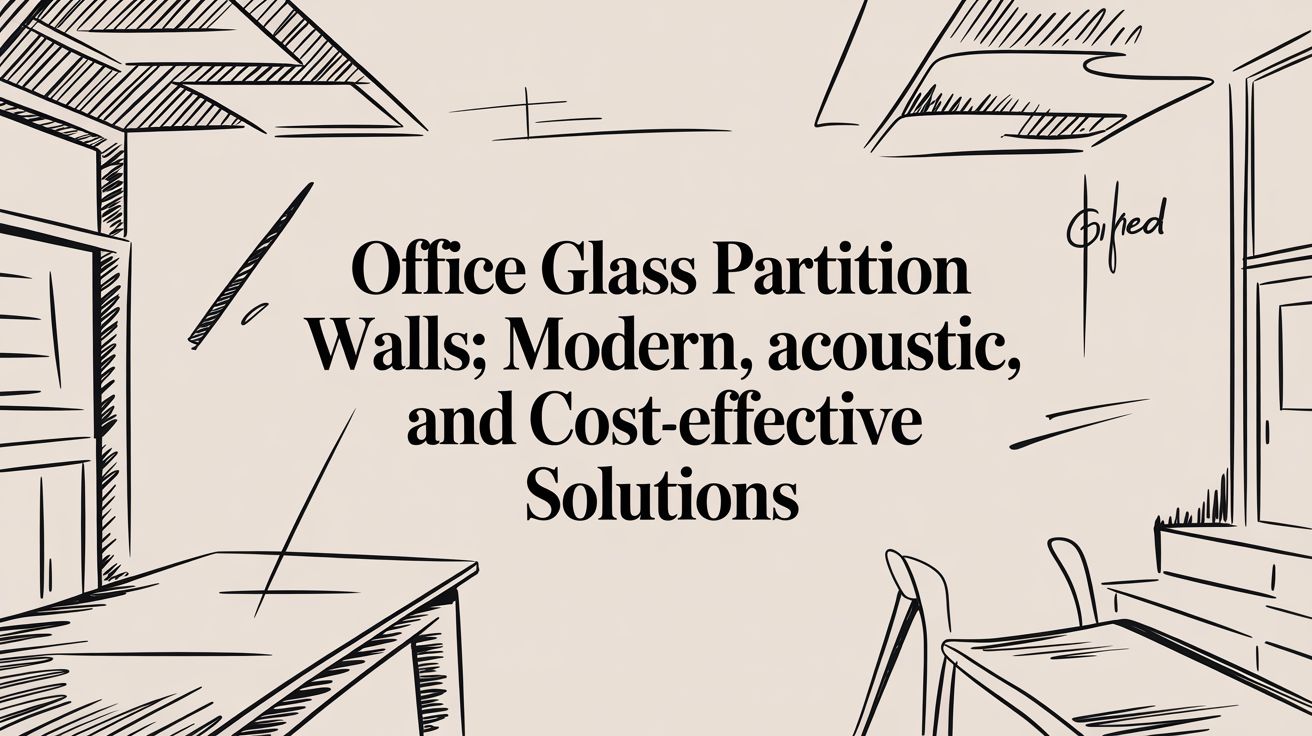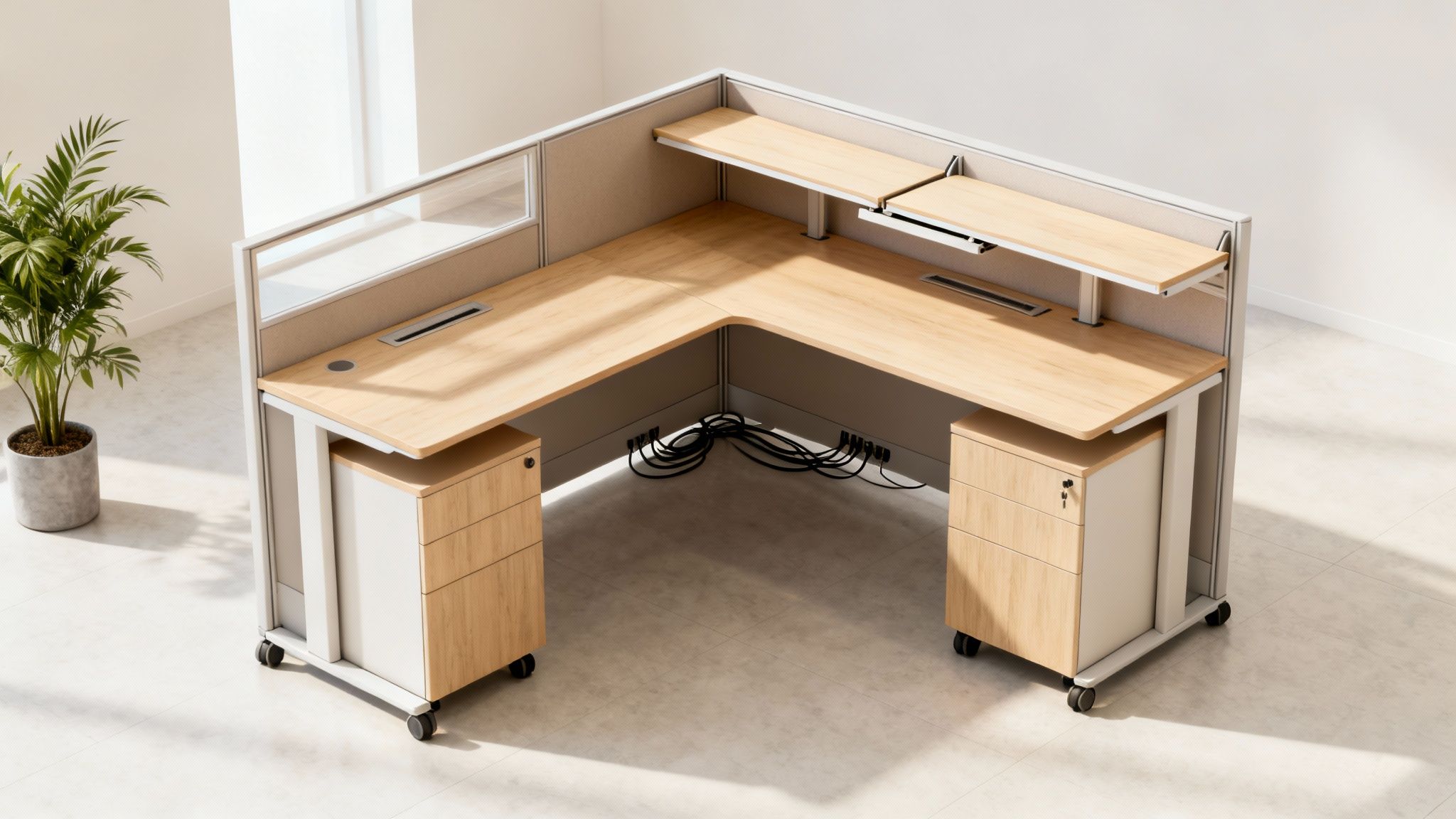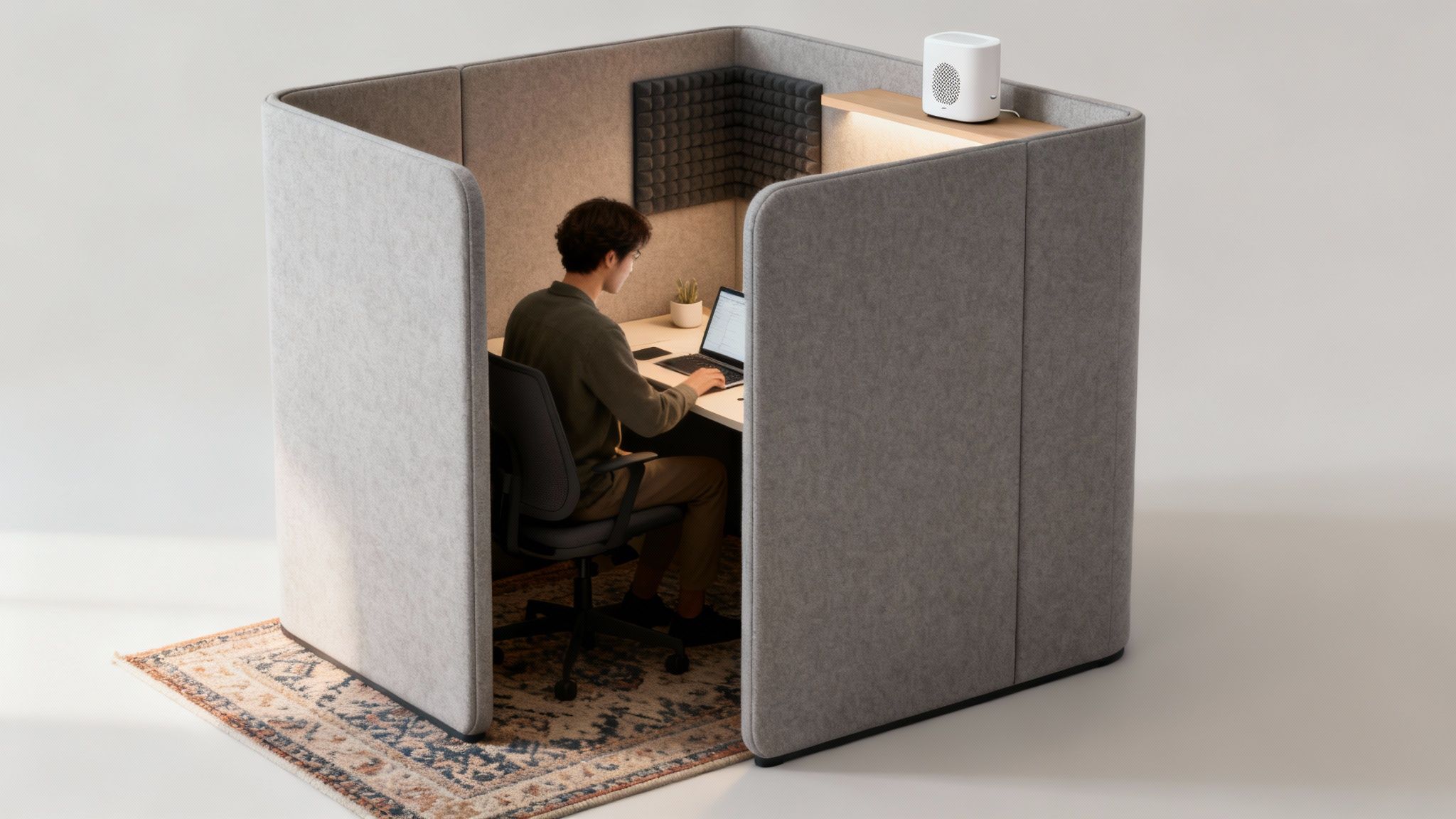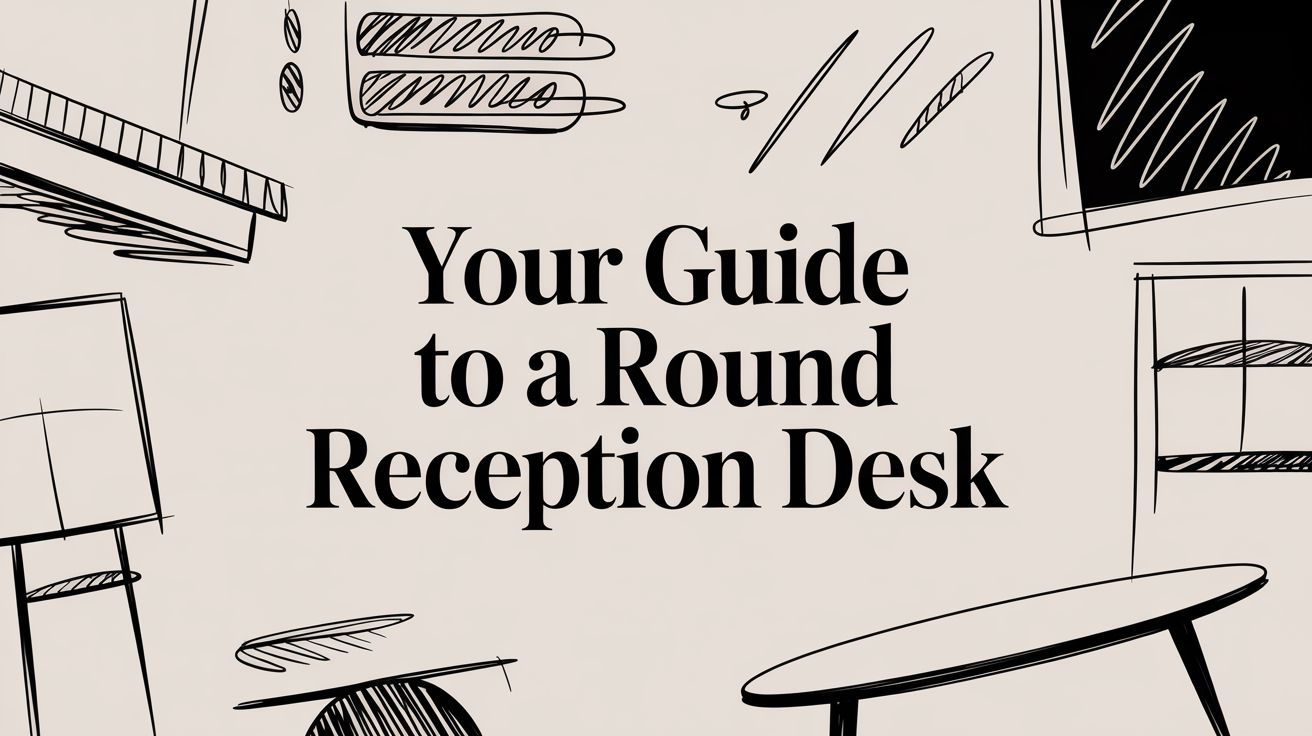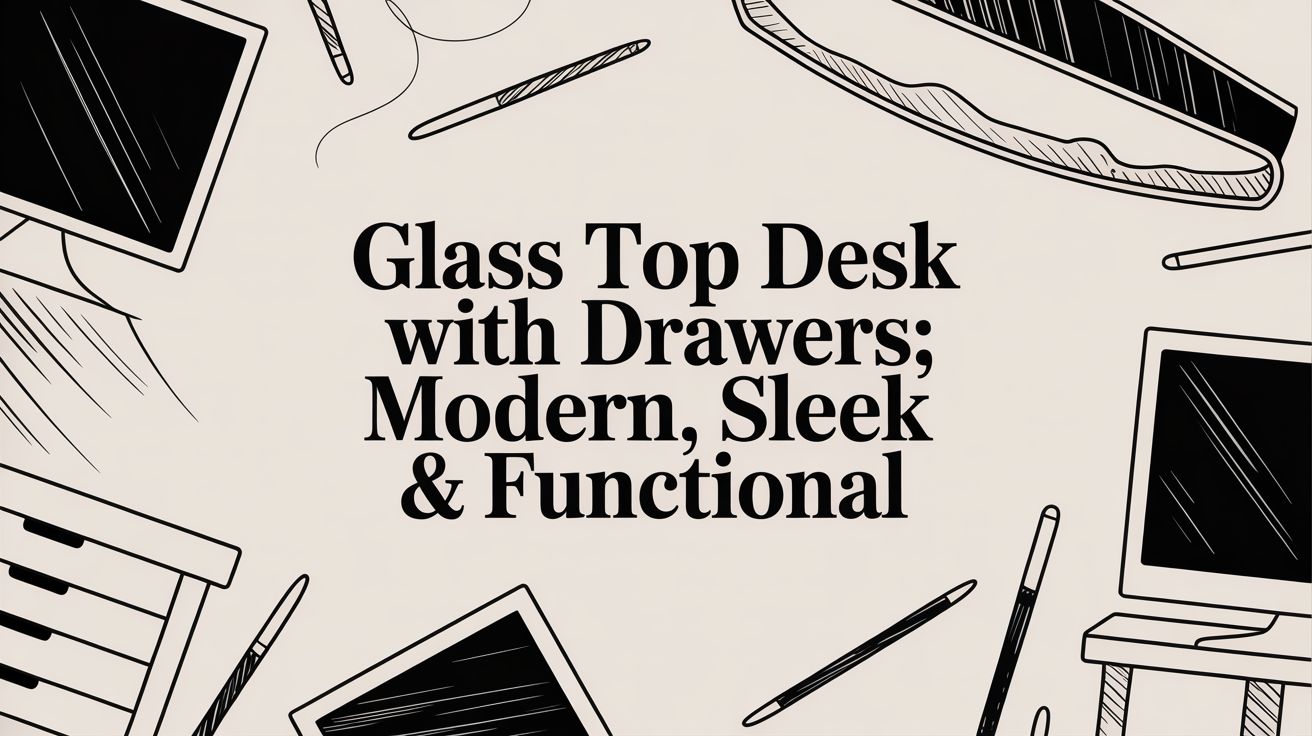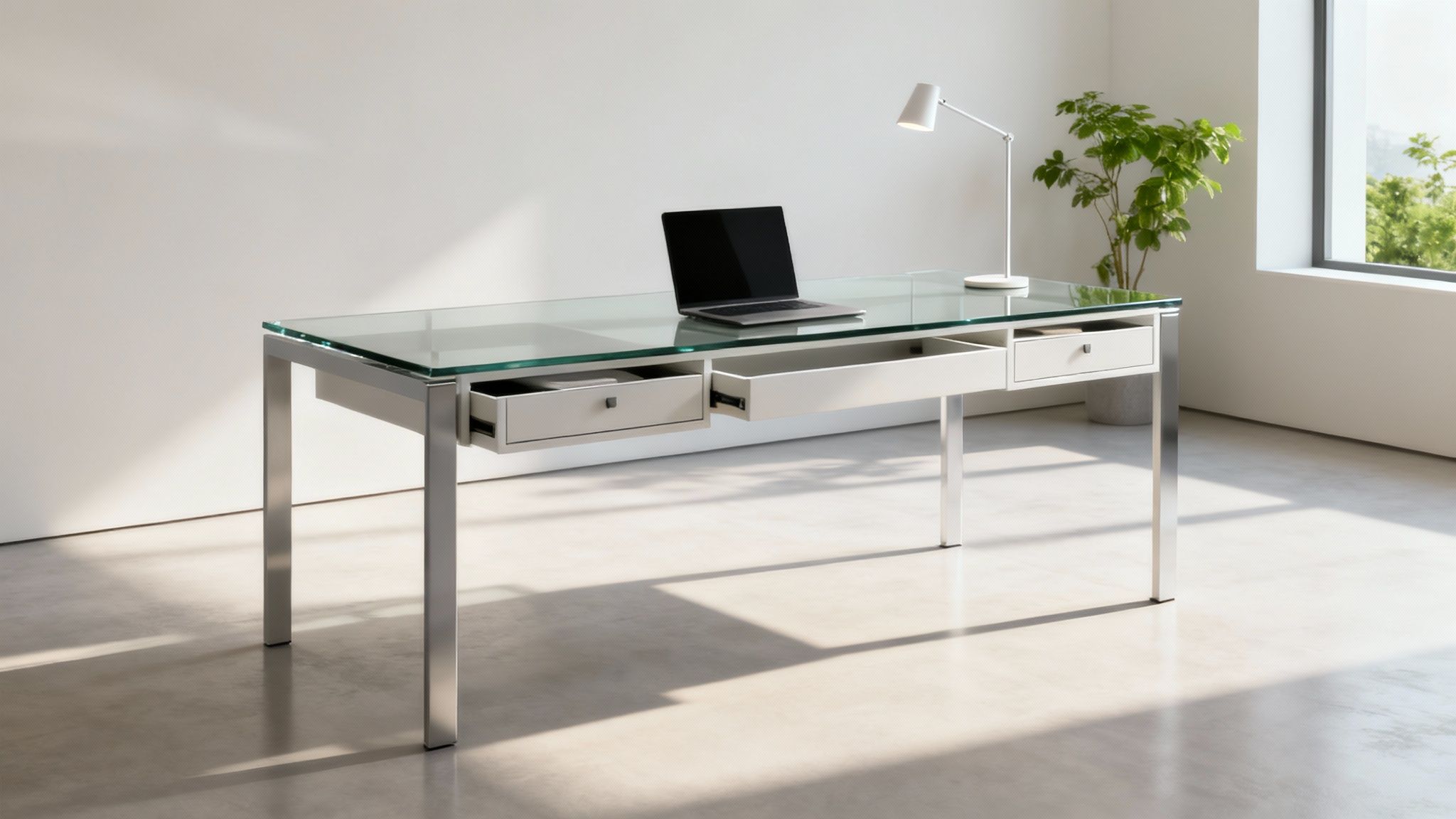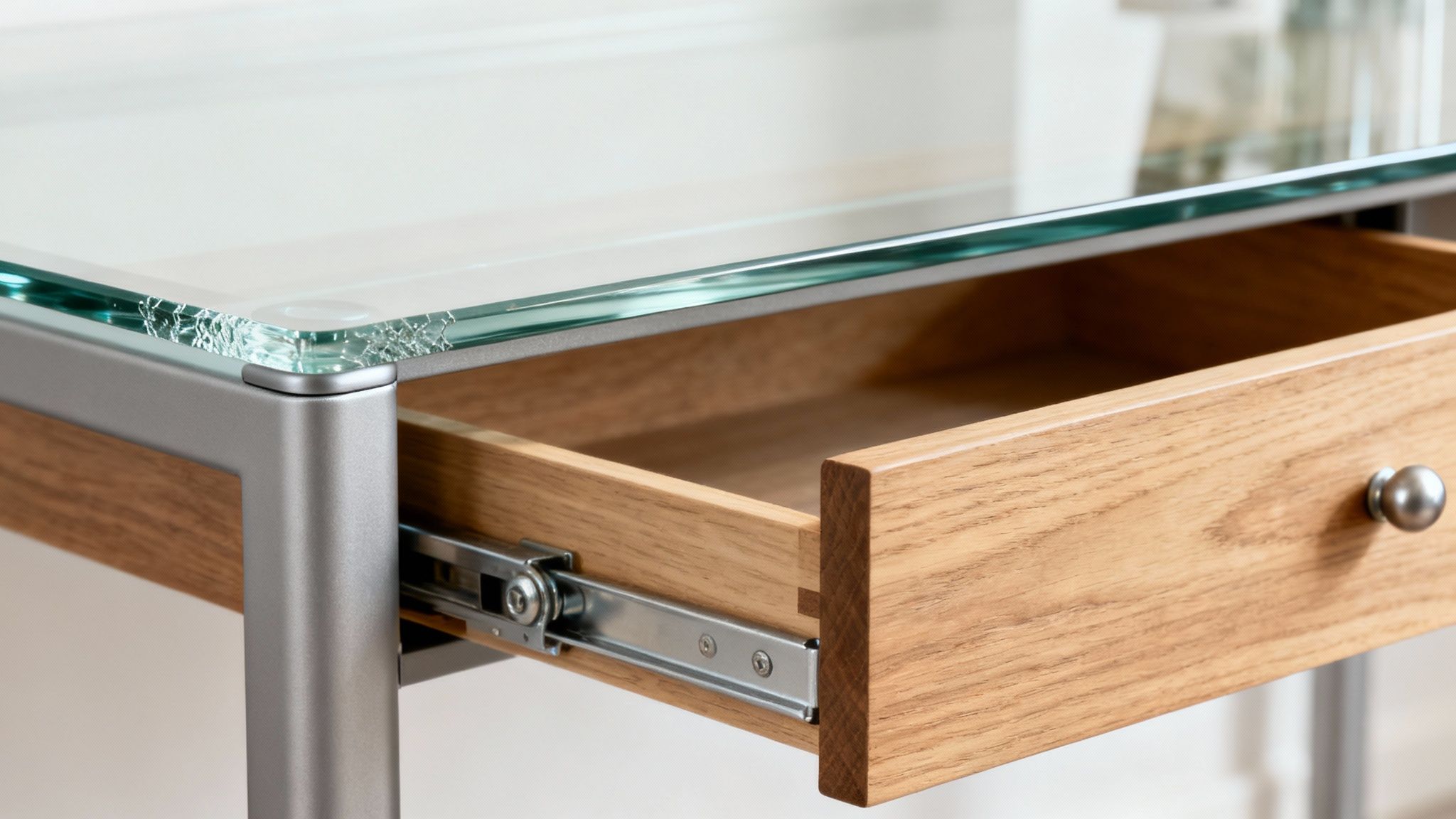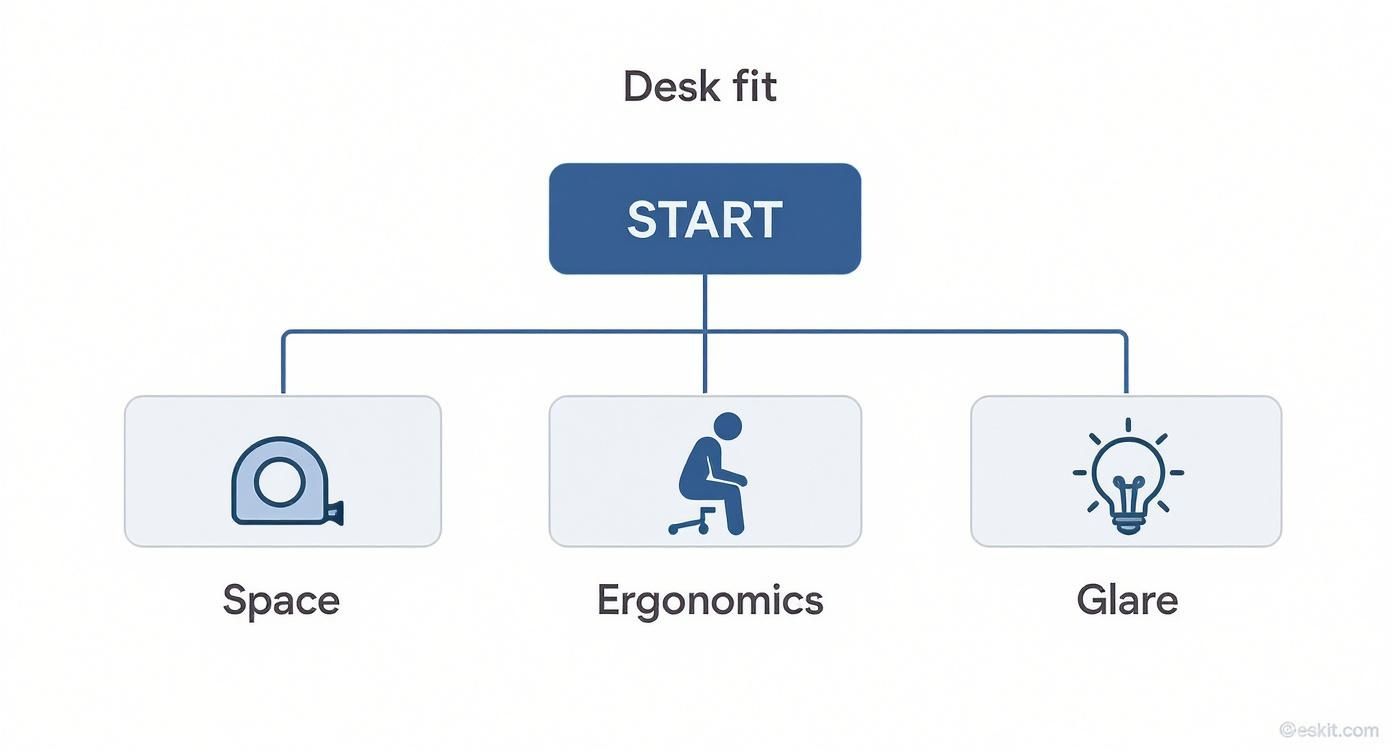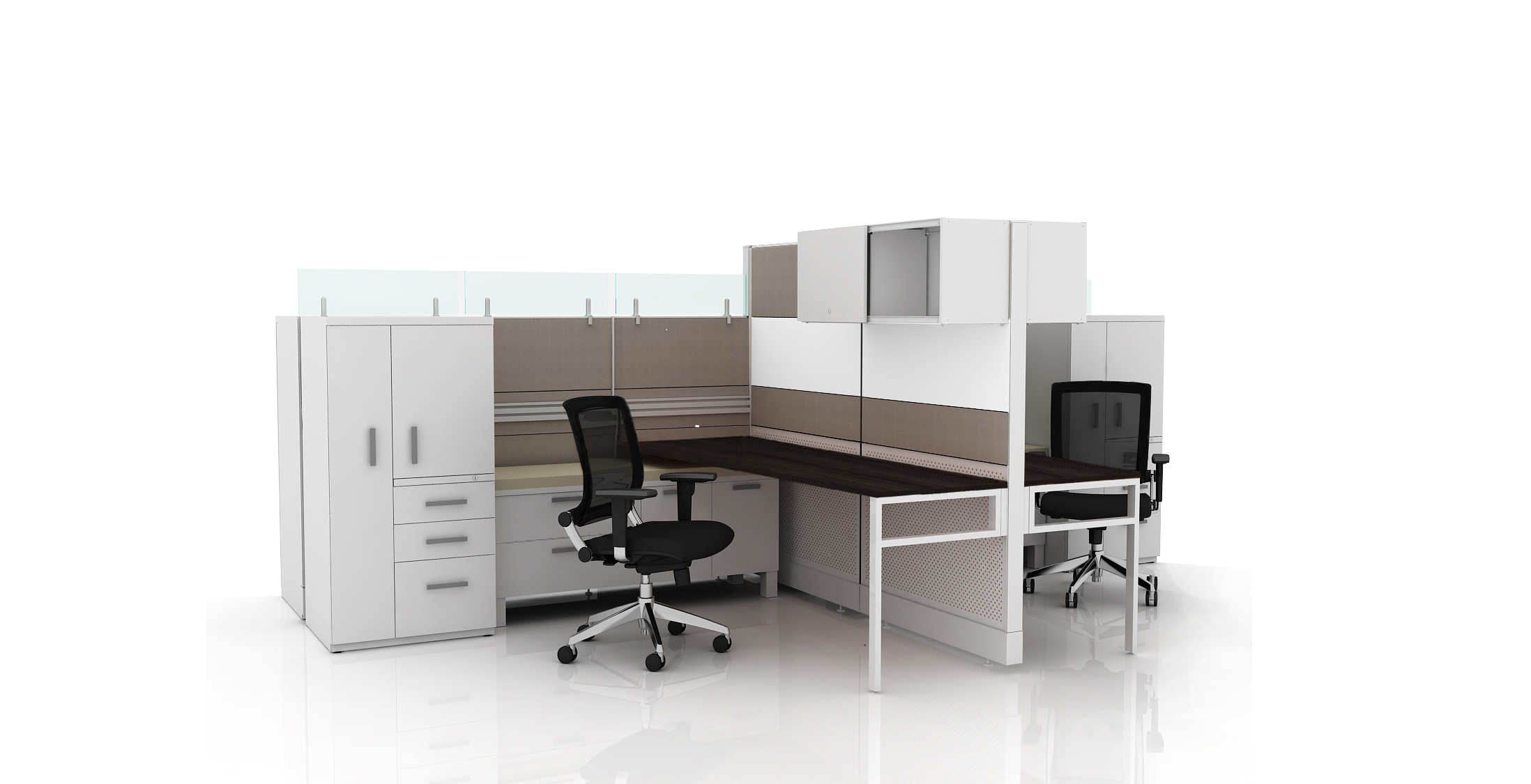12 Dec Office Glass Partition Walls: Modern, Acoustic, and Cost-Effective Solutions by Cubicle By Design
Office glass partitions are room dividers made from glass panels, designed to create separate offices, meeting rooms, or zones within a larger space without sacrificing an open, light-filled feeling. They are a fantastic modern alternative to traditional drywall, offering far more flexibility and a much cleaner look. At Cubicle By Design, we help businesses leverage these systems to build dynamic and efficient workspaces.
Reimagining the Modern Workspace with Glass Partitions
Walk into a cutting-edge office today, and you'll likely notice something different. The days of stuffy, solid-walled offices and isolating cubicles are fading fast, replaced by something brighter, more connected, and a lot more collaborative. Office glass partition walls are at the heart of this shift.
These aren't just panes of glass; they're strategic tools that fundamentally change how teams work together. They strike that perfect balance between the modern desire for open, light-filled spaces and the age-old need for quiet, focused work. Think of them as the key to unlocking a more dynamic and energized office. At Cubicle By Design, we've seen firsthand how these systems can turn a monotonous floor plan into a motivational powerhouse.
Why Glass Walls Are a Cornerstone of Modern Office Design
The move toward glass partitions isn't just some passing fad—it's a direct response to what today's workforce needs to succeed. Companies are ditching opaque barriers that create silos, opting instead for solutions that foster a sense of community and well-being. This isn't a new idea, but it's gained serious momentum over the last decade.
In fact, the adoption of glass partitions has become a defining feature of modern office design. By 2023, over 40% of corporate offices worldwide had already integrated these systems. This isn't just a local trend; it's a global embrace of glass for its ability to promote both transparency and pure functionality. You can discover more insights on the glass partition market here.
By allowing natural light to flow deep into an office, glass walls don't just cut down on energy bills—they make people feel better. Studies have consistently shown that good access to natural light can reduce eye strain, fight off afternoon drowsiness, and even cut down on headaches.
The Strategic Benefits Beyond Aesthetics
While they look incredibly sleek, the real value of glass walls goes far beyond just good looks. They offer seriously practical solutions to common workplace problems, making them a smart investment for any business looking to improve its space. These systems are a huge part of successful workplace design trends that put both employee experience and business efficiency first.
To make it simple, here are the core advantages in a nutshell.
Key Benefits of Glass Partition Walls at a Glance
| Benefit | Impact on Your Office |
|---|---|
| Enhanced Collaboration | Visual connection encourages spontaneous chats and strengthens team spirit. |
| Improved Flexibility | Modular systems can be moved and reconfigured as your company evolves. |
| Acoustic Privacy | Double-glazed or laminated glass creates quiet zones without total isolation. |
| Increased Natural Light | A brighter space leads to a healthier, happier, and more productive team. |
Ultimately, glass partitions do more than just divide a room. They help you build a more adaptable, collaborative, and human-centric workplace.
Choosing Your Style: Framed vs. Frameless Systems
Picking between framed and frameless office glass partitions is a lot like choosing between a classic framed painting and a sleek, modern canvas print. They both look fantastic, but they create entirely different moods in a room. This isn't just a minor detail; it's a foundational choice that will shape your office's atmosphere, workflow, and overall vibe.
Framed systems give you a strong, structured look—think industrial or traditional—while frameless systems deliver that seamless, all-glass aesthetic that feels open and cutting-edge. To figure out which is right for you, we need to dig into the practical differences in how they look, how they're installed, how well they block sound, and what they cost.
The Bold Statement of Framed Glass Systems
Framed glass partitions are the workhorses of office design. They’re known for being incredibly durable and having a strong visual presence. The metal framing, which is usually aluminum, outlines each glass panel and creates a distinct grid-like pattern that can define a space with real authority and style.
You can think of these systems as having a visible skeleton. This structure adds to that classic or industrial feel, but it also provides serious support, making it a great choice for high-traffic hallways and busy common areas. The frames also create a tighter seal around the glass, which usually means better acoustic performance. This makes them perfect for carving out quiet spaces, like our Private Office Cubicles.
The Minimalist Appeal of Frameless Glass Walls
If your goal is to maximize natural light and create the illusion of a much bigger space, frameless glass partitions are the answer. These systems use the bare minimum of hardware. Glass panels meet edge-to-edge, held together by discreet clamps and nearly invisible seals. The end result is a stunning, uninterrupted wall of glass that feels both weightless and incredibly sophisticated.
This 'all-glass' look is a huge hit in modern office design because it builds a culture of transparency and connection. It lets sunlight pour across the entire floor plan, and studies have shown that more natural light can reduce employee drowsiness by 56% and headaches by 63%. It's the go-to style for companies wanting to foster collaboration without putting up solid, view-blocking walls.
The demand for this clean look is so high that frameless glass partitions now command 42.8% of the market share. Companies are redesigning their spaces to find that sweet spot between collaboration and privacy, and this style nails it.
This decision tree can help you connect your main goal—whether it's more light, better focus, or easier collaboration—with the right type of system.
As the flowchart suggests, if flooding your space with light is the top priority, a frameless system is your best bet. On the other hand, framed options are the clear winner for creating focused, quiet zones.
Framed vs. Frameless Glass Partitions Comparison
To make the choice even clearer, here's a side-by-side comparison of the two systems. Think of this as a quick cheat sheet to see which style's pros and cons align best with your office's needs.
| Feature | Framed Glass Partitions | Frameless Glass Partitions |
|---|---|---|
| Aesthetics | Structured, bold, industrial look with visible aluminum frames. | Sleek, minimalist, 'all-glass' appearance with minimal hardware. |
| Acoustics | Generally superior soundproofing due to better seals from the frame. | Good sound control, but the seals between panels are less robust. |
| Light Flow | Excellent light transmission, but frames create visual breaks. | Uninterrupted flow of natural light, making spaces feel larger. |
| Durability | Extremely durable and well-suited for high-traffic areas. | Very durable, but edges can be more vulnerable to direct impact. |
| Cost | Often more budget-friendly for standard configurations. | Can be more expensive, but installation may be faster. |
| Best For | Private offices, conference rooms, and areas needing high noise control. | Open-plan environments, collaborative spaces, and modern designs. |
Ultimately, both are fantastic options. The decision comes down to what you're trying to achieve: the robust, quiet focus of a framed system or the bright, open transparency of a frameless one.
Making the Right Choice for Your Space
Your final decision will come down to balancing looks, function, and budget. Here’s a quick breakdown to help you think it through:
- For Acoustic Privacy: If keeping sound in (or out) is your top concern for meeting rooms or executive offices, a framed system is almost always the better choice. Double-glazed framed partitions offer the best soundproofing you can get.
- For Maximum Openness: If you want a bright, airy, and visually connected office, a frameless system simply can't be beaten. It’s the best way to make a smaller space feel much larger and more welcoming.
- For Budget Considerations: Framed systems can sometimes be a bit easier on the wallet, especially for standard layouts. However, the installation for frameless systems can be faster, which might help balance out the total project cost.
- For Installation Complexity: No matter which you choose, professional installation is a must to ensure everything is safe, secure, and performing as it should. To get a feel for the process, take a look at our guide on glass architectural wall installation.
The right system isn't just a physical divider; it's a tool that helps shape your company culture. A frameless wall sends a message of transparency and collaboration, while a framed wall can signify stability and focus.
The best way to really know what will work is to see it for yourself. You can play around with different layouts and see how these styles look in your space with our free Cubicle Designer tool. It’s a great way to turn an idea into a solid plan for your new workspace.
Mastering Acoustics and Privacy in Glass Offices
An open office aesthetic is fantastic, but it shouldn't come at the cost of a chaotic, noisy environment. While office glass partition walls are celebrated for creating bright, connected workspaces, their real magic is how they deliver acoustic serenity and visual privacy right where you need it most. It's all about choosing the right type of glass to transform an open floor plan into a collection of calm, focused zones.

The key to unlocking this peace and quiet is a term you'll hear a lot: Sound Transmission Class (STC) rating. Think of it as a noise-canceling score for your walls. The higher the STC number, the better the partition is at stopping sound in its tracks.
A standard, single-pane glass wall might have an STC rating in the low 30s. That's enough to muffle conversations, but you'll still hear what's going on. But with the right technology, glass partitions can hit STC ratings of 40 or higher, putting them on par with traditional drywall and ensuring confidential conversations stay that way.
How Different Glass Types Control Sound
Not all glass is created equal when it comes to acoustics. The secret to serious sound control is in how the glass panels themselves are built. Different techniques are used to disrupt and absorb sound waves before they can travel from one room to the next.
Here are the main types you’ll run into:
- Standard Tempered Glass: This is your baseline. It's a strong, durable safety glass, but it offers only minimal acoustic help. It's best for areas where noise just isn't a major concern.
- Laminated Acoustic Glass: This is a clever sandwich. It features a thin, invisible layer of plastic (polyvinyl butyral, or PVB) between two panes of glass. This middle layer acts as a vibration-dampening core, making it much better at blocking mid-to-high frequency sounds—like human speech.
- Double-Glazed (Insulated) Glass: This system is the heavy hitter. It uses two separate panes of glass with an air or gas-filled gap in between. That gap creates a powerful insulating barrier that's exceptionally good at blocking a wide range of sound frequencies, making it the top choice for executive offices or boardrooms.
The right choice really depends on the needs of the space. For a bustling sales floor, standard glass might be fine. But for sensitive HR meetings or legal consultations, investing in double-glazed systems is a must.
A well-designed office uses a mix of acoustic solutions. A high-STC glass wall for a meeting room combined with sound-absorbing ceiling tiles and carpets in the open area creates a balanced acoustic environment for everyone.
More Than Just Sound: Visual Privacy Solutions
Acoustic control is only half the battle. Visual privacy is just as important for creating comfortable and secure workspaces. Fortunately, glass partitions offer a whole spectrum of creative solutions to control who sees what, without having to resort to clunky blinds or curtains.
These options let you dial in the perfect level of privacy, from subtle obscurity to complete opacity. You can make sure your team has the confidentiality it needs to perform at its best. For a deeper dive into creating secluded spaces, our guide on achieving office cubicle privacy offers even more strategies.
Modern Solutions for Visual Privacy
| Privacy Type | How It Works | Best For |
|---|---|---|
| Frosted or Etched Glass | The glass is sandblasted or acid-etched to create a translucent, blurred effect. | Conference rooms and individual offices where you want to hide details but still let light stream through. |
| Decorative Film | A vinyl film with patterns, gradients, or branding is applied directly to the glass. | Adding a layer of design and branding while providing partial or full visual privacy in a cost-effective way. |
| Switchable Smart Glass | An electrical current passes through a film, turning the glass from clear to opaque with the flick of a switch. | High-tech boardrooms and executive suites where on-demand privacy is needed for confidential meetings. |
By combining advanced acoustic glass with these smart visual privacy options, you can design an office that feels open and collaborative yet provides the quiet and confidentiality that productive work demands. It’s this strategic blend that makes a workspace not just beautiful, but truly functional.
Strategically Planning Your Office Layout
Putting up office glass partition walls isn't just about slicing up a room; it’s about designing a smarter, more productive workflow. A well-planned layout is more than just good looks—it actively supports how your team works day-to-day, encourages the right kinds of conversations, and shapes an environment where people can truly focus. Think of it as the blueprint for turning a basic floor plan into a dynamic, efficient workspace.
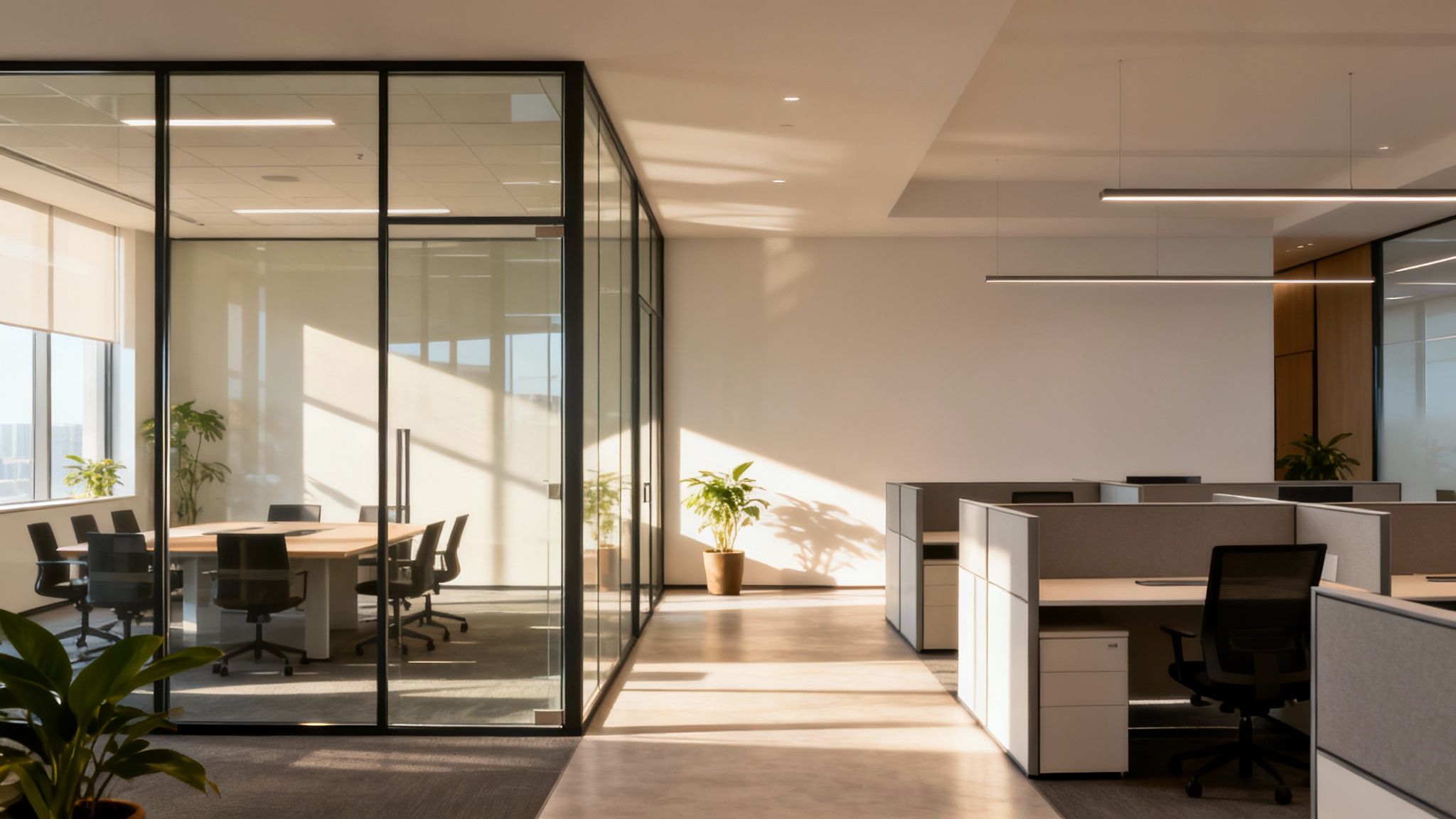
The first step is to start thinking in zones, not just rooms. Every office has different kinds of activity, and your layout needs to serve all of them. By placing glass walls strategically, you can define these areas without throwing up solid barriers that kill collaboration and block off the space.
Designing Functional Zones with Glass
Your real goal here is to create a seamless flow between different work modes. Glass partitions are the perfect tool for the job. They give you the separation you need while keeping that feeling of openness and connection across the entire office.
Here’s a practical way to think about creating your key zones:
- Collaborative Hubs: These are your high-energy spots for brainstorming and teamwork. You can use clear glass walls to enclose these spaces near common areas. This keeps the sound from spilling out but lets the creative energy stay visible, which can actually inspire others.
- Deep Work Areas: Everyone needs a quiet place to get into the zone. Try to position these areas away from high-traffic paths and use acoustically rated glass partitions to cut down on distractions. Adding frosted or etched glass can give an extra layer of visual privacy without making the space feel dark. Consider layouts with our workstation cubicles to maximize focus.
- Formal Meeting Rooms: When it's time for client meetings or sensitive discussions, double-glazed glass walls are the way to go for maximum acoustic privacy. It sends a message of professionalism and security while still feeling connected to the rest of the office.
This kind of thoughtful space division is what makes a workspace truly successful. To really nail it, it’s best to consider the entire office building layout plan and see how glass elements fit into the bigger picture.
Harnessing Natural Light for a Better Workplace
One of the biggest wins you get from planning with glass is the ability to pull natural light deep into your office. Traditional walls are notorious for creating dark interior hallways and offices, making you rely on artificial lighting that can cause eye strain and that classic afternoon slump.
Glass partitions, on the other hand, act like channels for sunlight, letting it flood every corner. This one simple change can have a massive impact on both your team’s well-being and your bottom line. It’s been shown time and again that access to natural light boosts mood, sharpens focus, and even reduces absenteeism. It all adds up to a healthier, more productive crew.
The rise of rapid urbanization has made office space a premium commodity. By using glass, you can create a layout that feels expansive and bright, even in a smaller footprint.
In fact, you can see this trend in action—around 80% of new urban commercial buildings are now designed with glass partitions in mind. This approach allows for an average 20% space optimization compared to solid walls, which is a huge advantage when you're trying to keep real estate costs down.
The Power of Modularity and Future-Proofing
Maybe the smartest reason to go with glass partition systems is their modularity. Unlike drywall, these walls aren’t a permanent decision. They are designed to be demountable, which means you can reconfigure them as your company grows and your needs evolve.
This flexibility is a massive asset. If a department suddenly expands or you need to carve out a new project room, the layout can be changed over a weekend with very little mess or disruption. This makes glass partitions a smart, sustainable investment that grows right along with your business.
For help creating a layout that works for you now and in the future, explore our expert office space planning and design services.
Navigating Costs, Installation, and Long-Term Care
So, let's talk about the practical side of things. You see the appeal of office glass partition walls and how they can transform a space, but what’s the real story when it comes to the investment? From the initial quote to the installation day and beyond, getting a handle on the costs and logistics is key to smart planning. This is where we break down the numbers and the process, so you can feel confident your glass partitions will deliver value for years to come.
Breaking Down the Costs of Glass Partitions
The final price for a glass wall system isn't a simple, one-size-fits-all number. It’s more of a recipe, where your design choices, performance needs, and the project’s complexity are all key ingredients. The best way to get a firm number is always a custom quote, but understanding what drives the cost will help you set a realistic budget from the get-go.
A few big factors will shape your total investment:
- System Type: Frameless systems often carry a higher material cost because they require thicker, perfectly finished glass. On the flip side, their installation can sometimes be quicker, which helps balance out the overall project price.
- Glass Specifications: The type and thickness of the glass are major variables. A standard single-pane tempered glass is your most budget-friendly option. If you need serious soundproofing or high-tech features, you'll be looking at double-glazed acoustic glass or switchable smart glass, which represent a more significant investment.
- Hardware and Finishes: Even the little things matter. The style and finish of frames, door handles, and hinges play a part. A standard brushed aluminum finish is going to be more economical than a custom powder-coated color or premium designer hardware.
- Customization: Anything outside the standard playbook—like curved glass, custom-etched logos, or extra-tall panels—will naturally add to the final cost.
It’s easy to get fixated on the upfront price, but don't forget the long-term ROI. Glass partitions are incredibly durable and low maintenance. You won't be spending money patching and repainting drywall every few years, and their flexibility saves a fortune on future reconfigurations.
The Critical Role of Professional Installation
Here’s a piece of advice I can’t stress enough: installing glass partitions is a job for the pros. This is not a DIY weekend project. While it might look straightforward, getting a flawless, safe, and secure installation requires a level of precision and expertise that only comes with experience.
Professional installers are trained to handle every detail, from taking hyper-accurate site measurements to safely maneuvering heavy glass panels into place. They ensure every seal is perfectly aligned to block sound leaks and that the entire structure is solid. A proper installation is the difference between a system that looks incredible and performs perfectly for a decade, and one that causes headaches down the road.
At Cubicle By Design, our teams live and breathe this stuff. To get a better sense of what’s involved, you can learn more about our professional office furniture installation services.
Long-Term Care and Simple Maintenance
One of the best things about office glass partition walls is how ridiculously easy they are to take care of. Forget about drywall that gets scuffed, dented, and needs constant touch-ups. Glass is a tough, non-porous surface that asks for very little in return.
Keeping your partitions looking brand new is simple:
- Regular Cleaning: A simple mix of water and mild soap, or just a standard glass cleaner, is all you need. Use a soft, lint-free cloth to avoid streaks. Just steer clear of abrasive powders or scouring pads that could scratch the surface.
- Hardware Checks: Every once in a while, give the door handles, hinges, and other hardware a quick check to make sure everything is tight and secure. A quick turn of a screwdriver is usually all it takes.
- Seal Inspection: About once a year, take a quick look at the seals between the glass panels and where they meet the floor and ceiling. This makes sure the soundproofing is still holding up perfectly.
That’s pretty much it. With just a tiny bit of effort, your glass partitions will maintain their clean, modern look for years, making them one of the most sustainable and cost-effective choices you can make for a modern office.
Understanding Safety and Building Code Essentials
When you’re planning a modern office, it’s easy to get caught up in the look and feel of things like office glass partition walls. And while that’s the exciting part, safety is the foundation every great installation is built on. Diving into safety standards and building codes might sound intimidating, but it’s actually pretty straightforward once you know what to look for.
Getting this right isn't just about ticking boxes. It’s about creating a genuinely secure environment for your team and protecting your business from liability down the road.
The heart of glass partition safety comes down to the glass itself. Your everyday window glass—known as annealed glass—has absolutely no place in an office wall. Regulations require specialized safety glass that’s engineered to prevent serious injury if it ever breaks. Working with an expert like Cubicle By Design means you can rest easy knowing every single panel we install meets these critical standards.
The Non-Negotiable Role of Safety Glass
Think of safety glass as an insurance policy. You hope you never need it, but you absolutely have to have it. Building codes demand its use in partitions, doors, and any large glass features where people might accidentally bump into it.
You’ll mainly come across two types:
- Tempered Glass: This glass goes through a serious heating and rapid cooling process that makes it four to five times stronger than regular glass. But its real magic is in how it breaks. Instead of creating dangerous, sharp shards, it shatters into small, dull, pebble-like pieces that are far less likely to cause harm.
- Laminated Glass: This is basically a glass sandwich. It’s made of two or more layers of glass fused together with a tough plastic interlayer (PVB). If laminated glass cracks, that interlayer does an amazing job of holding all the fragments in place, keeping the barrier intact and preventing glass from scattering everywhere.
Decoding Fire Ratings and Compliance
Beyond impact safety, fire resistance is another huge deal, especially in commercial buildings. Certain walls, particularly those along escape routes, might need to have a specific fire rating. This rating tells you exactly how long a partition can hold back a fire and stop it from spreading.
Fire-rated glass and framing systems are designed to contain a fire for a set amount of time—like 20, 45, or 60 minutes—giving everyone precious time to evacuate safely. When you're picking materials, even decorative films for the glass, you have to be sure they don't compromise the wall's fire rating. It's always a good idea to get familiar with understanding UL fire safety standards to make sure everything is compliant.
Ensuring Accessibility for Everyone
A modern workspace has to work for everyone. The Americans with Disabilities Act (ADA) lays out clear rules to make sure people with disabilities can move through and use the office without barriers. For glass partitions, this usually means focusing on a few key things:
- Clearance Requirements: Doorways need to be wide enough for easy wheelchair access.
- Door Hardware: Handles and levers should be easy to use with one hand, without needing to grip them tightly.
- Visual Cues: Large, clear panes of glass need some kind of marking or "distraction graphic" at specific heights so people don't accidentally walk into them.
Navigating all these codes and regulations is a core part of what we do. From our modular cubicles to complex glass wall systems, we make sure every component aligns with local building codes and ADA standards. The end result is a workspace that’s not only beautiful but also safe, compliant, and welcoming for every single person on your team.
Got Questions About Office Glass Walls? We Have Answers.
Making the move to a more modern, open-feeling office is a big decision, and it’s totally normal to have questions. When you're thinking about integrating office glass partition walls, you need clear, straightforward answers. We've gathered the most common questions we hear from clients to give you the practical info you need to move forward with confidence.
Think of this as a quick-reference guide to reinforce some of the key ideas we've covered, helping you find what you need fast.
How Good Are Glass Partitions at Blocking Office Noise?
They are incredibly effective, but only if you choose the right type of glass. A basic, single pane of glass will only offer minimal sound reduction, but the specialized options can make a world of difference. For instance, acoustic glass—like laminated or double-glazed panels—can hit an STC rating of 40 or higher, which is right up there with traditional drywall.
The real secret is matching the glass specification to what the room will be used for. It’s also critical to have a professional installation that properly seals up any potential sound leaks around the frames and joints.
A lot of our clients are surprised when they learn that a double-glazed glass wall can be just as good at blocking sound as a standard insulated stud wall. It’s all about creating an air gap that disrupts the sound waves, which just goes to show you don't have to sacrifice a quiet space for an open feel.
Are Office Glass Partition Walls Safe and Durable?
Absolutely. Any reputable supplier, including Cubicle By Design, will only use tempered or laminated safety glass, which is what building codes demand. These materials are specifically engineered to handle the demands of a commercial environment.
Tempered glass is roughly five times stronger than regular glass and is designed to crumble into small, dull-edged pieces if it ever breaks, which dramatically reduces the risk of injury. Laminated glass has a polymer layer sandwiched inside that holds the pane together even if it shatters, keeping the barrier intact. Both are built to handle the daily rigors of a busy office, from accidental bumps to frequent cleaning, making them a safe and long-lasting choice.
Can We Move or Reconfigure Glass Partitions Later On?
Yes, and this flexibility is honestly one of their biggest selling points. Many systems, often called "demountable walls," are designed from the ground up to be non-permanent fixtures. This means they can be carefully taken down and reinstalled in a new layout with very little disruption, dust, or waste.
This modular design makes them a smart, sustainable investment, especially for businesses that expect to grow or change how they use their space. You can adapt your office as your team evolves without the high costs and mess that come with traditional demolition and construction.
How Much Natural Light Will We Actually Get with Glass Walls?
Glass partitions are simply unmatched when it comes to maximizing natural light in an office. A clear, full-height glass wall allows pretty much all the available sunlight to flow deep into your space, brightening up interior areas that would otherwise be stuck with artificial lighting all day.
This doesn't just create a more vibrant and welcoming atmosphere; it has real, tangible benefits for your team. Studies have shown that employees who get more natural light report 56% less drowsiness and 63% fewer headaches. It's a simple change that can lead to a healthier, more alert, and more productive group of people.
Ready to create a brighter, more flexible, and productive workspace? The experts at Cubicle By Design can help you plan, design, and install the perfect office glass partition walls for your unique needs. Explore our solutions and see how we can transform your office.
Explore our full range of modular cubicles and office solutions today!

